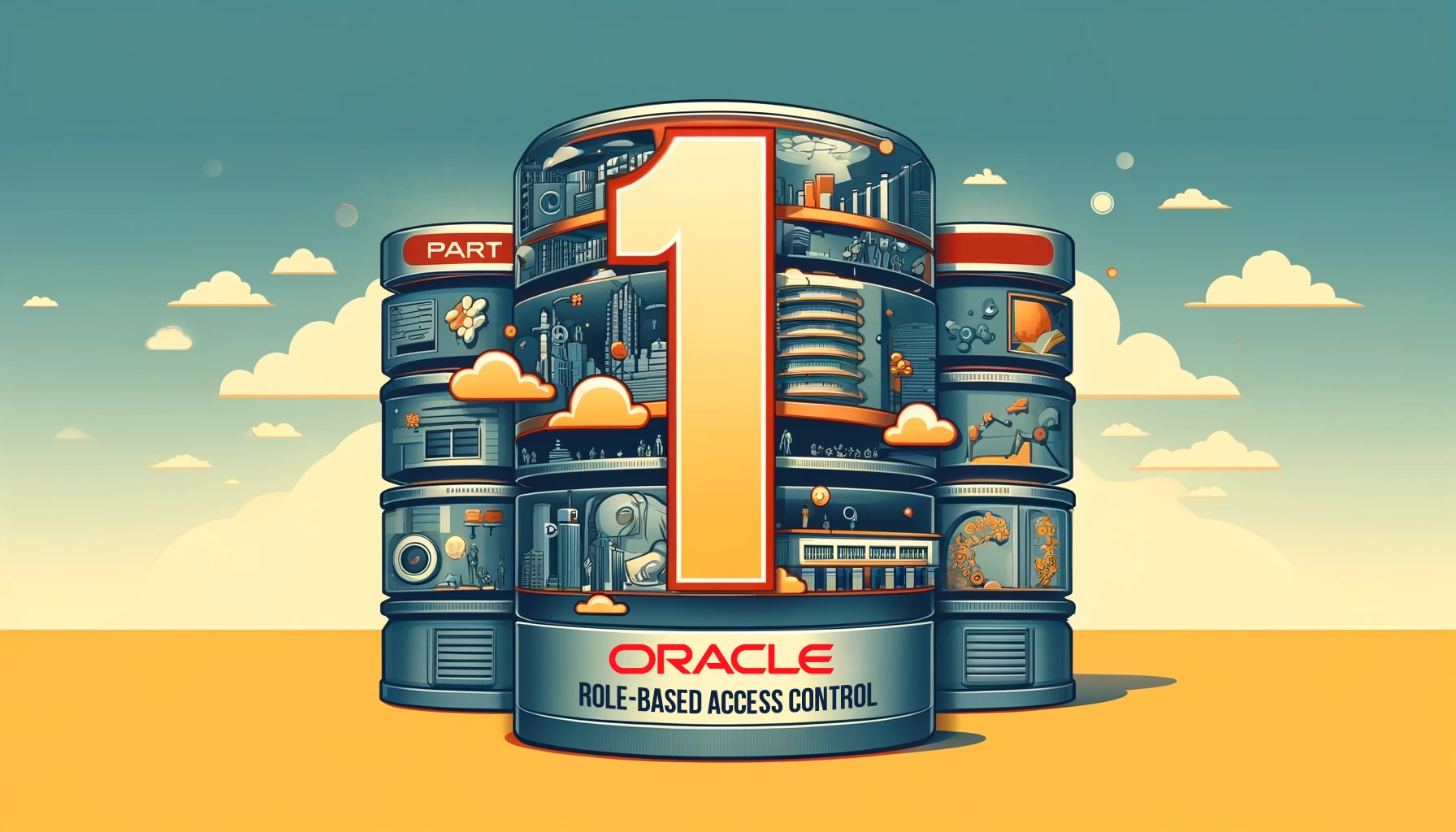
Mastering Oracle’s Native RBAC: A Comprehensive Guide – Part 1

1. Introduction
In today’s data-driven world, securing sensitive information is crucial. Organizations must implement robust access control mechanisms to protect their valuable data assets. RBAC is a common access control model known for its flexibility and scalability compared to other models.
Oracle, a leading provider of database management systems, offers a powerful native RBAC implementation. RBAC helps organizations establish and enforce access rules according to user roles. This simplifies permission management and ensures that users only have access to what is necessary for their job.
In this detailed guide, we will explore Oracle’s native RBAC system, covering its main ideas, setup process, and recommended methods. Whether you are a database administrator, security professional, or application developer, understanding RBAC is essential to effectively secure your Oracle database environment.
We will start by explaining the fundamental concepts of RBAC, including roles, privileges, and users. Then, we will walk through the process of configuring RBAC in Oracle, providing detailed examples and code snippets. We will also discuss advanced RBAC features such as role hierarchies and secure application roles. In this guide, we will stress the importance of using the least amount of access and controlling access in detail. We will look at how RBAC works with other access controls like ABAC and ACLs.
We will examine how system administrators manage RBAC. This includes assigning permissions, managing user accounts, and auditing access control policies. These practices are important for maintaining security. We will discuss network access control and how RBAC goes beyond the database to the operating system level. By the end of this guide, you will know how to use Oracle’s RBAC and control access in your Oracle database. You will gain the skills needed to implement access control effectively. This guide will help you understand RBAC and its application in Oracle databases. Let’s get started!
2. Understanding Role-Based Access Control (RBAC)
Let’s first understand the basics of role-based access control before we discuss Oracle’s specific implementation of RBAC.
2.1 What is RBAC?
Role-Based Access Control (RBAC) uses roles to decide who can access what. It’s a security model that manages permissions efficiently. RBAC assigns permissions to roles, not individual users. Users acquire permissions by roles assigning them. RBAC simplifies access control by grouping users based on their job roles or responsibilities within an organization. Roles group permissions together for easier management and maintenance of access policies.
2.2 Key Components of RBAC
To understand RBAC, let’s define its key components:
- Users: Individuals or entities that interact with the system and require access to resources.
- Roles: Named collections of permissions that define a specific job function or responsibility within an organization.
- Permissions: Fine-grained access rights or privileges that determine what actions can be performed on specific resources.
- Resources: Objects or entities within the system that users need to access, such as database tables, files, or applications.
In RBAC, users are assigned to roles, and roles are granted permissions on resources. This indirect assignment of permissions to users through roles simplifies access control management and reduces the complexity of managing individual user permissions.
2.3 Benefits of RBAC
Implementing RBAC offers several key benefits:
- Simplified Administration:RBAC reduces the administrative overhead of managing access rights for individual users. Roles have permissions, and users are put into roles, making it easier to manage access rules at a higher level.
- Better security: RBAC makes sure users can only access what they need for their job, following the least privilege principle. This minimizes the risk of unauthorized access and data breaches.
- Improved Compliance:RBAC helps organizations comply with security regulations and standards by providing a structured approach to access control. It enables auditing and reporting of user access rights, making it easier to demonstrate compliance.
- Scalability:RBAC scales well in large organizations with complex access control requirements. RBAC helps manage access policies efficiently by assigning roles as the number of users and resources increases.
- Flexibility:RBAC can adapt to changing organizational structures and job responsibilities. Users can easily create, modify, or delete roles to reflect changes in user roles and access requirements.
RBAC helps organizations manage access, enhance security, and ensure users have appropriate access for their tasks. This system simplifies the process of granting and revoking access permissions. It also helps prevent unauthorized access to sensitive information. Additionally, RBAC ensures that users only have access to the resources they need to perform their job effectively.
3. RBAC in Oracle Database
Oracle Database provides a robust implementation of RBAC through its native security features. Let’s explore how RBAC is implemented in Oracle and the key concepts involved.
3.1 Oracle Roles
In Oracle, roles are named collections of privileges that define a specific job function or responsibility. Roles serve as a logical container for grouping related privileges together. Oracle provides two types of roles:
- Database roles store database-specific privileges and are typically used to group them. The CREATE ROLE statement creates them.
- External roles are roles defined outside the database, like in the operating system or a directory service. The GRANT statement maps them to database roles.
Users or other roles can be granted roles in Oracle, allowing for the creation of role hierarchies. Role hierarchies enable the inheritance of privileges from one role to another, simplifying the management of complex access control structures.
3.2 Oracle Privileges
Privileges in Oracle determine the actions that users can perform on database objects. Oracle’s native RBAC provides two types of privileges:
- System Privileges:System privileges allow users to perform administrative tasks or access database-wide resources. Examples include creating tables, granting privileges, or backing up the database.
- Object Privileges:Object privileges allow users to perform specific actions on database objects, such as tables, views, or procedures. Examples include SELECT, INSERT, UPDATE, or DELETE privileges on a table.
Privileges can be granted directly to users or to roles. When a privilege is granted to a role, all users assigned to that role inherit the privilege. This simplifies the management of privileges and ensures consistent access control across users with similar job functions.
3.3 Oracle Users
In Oracle’s native RBAC, users are database accounts that connect to the database and interact with database objects. Each user receives a unique username and password and the system assigns them a default tablespace and temporary tablespace.
Users assign privileges directly or through roles. When a user is granted a role, they inherit all the privileges associated with that role. This allows for efficient management of user access rights based on their job functions or responsibilities.
Oracle provides several built-in user accounts, such as SYS and SYSTEM, which have extensive administrative privileges. It is important to secure these accounts and follow the principle of least privilege when creating and managing user accounts.
3.4 Implementing RBAC in Oracle
To implement RBAC in Oracle, you need to follow these general steps:
- Identify the roles and privileges required based on job functions and responsibilities.
- Create the necessary roles using the CREATE ROLE statement.
- Grant privileges to the roles using the GRANT statement.
- Create user accounts using the CREATE USER statement.
- Assign roles to users using the GRANT statement.
- Test and validate the access control policies to ensure users have the appropriate permissions.
Here’s an example of creating a role and granting privileges in Oracle:
-- Create a role named "hr_manager"
CREATE ROLE hr_manager;
-- Grant privileges to the "hr_manager" role
GRANT SELECT, INSERT, UPDATE ON employees TO hr_manager;
GRANT SELECT ON departments TO hr_manager;
-- Create a user named "john" and assign the "hr_manager" role
CREATE USER john IDENTIFIED BY password;
GRANT hr_manager TO john;
In this example, we create a role named “hr_manager.” This role is granted permission to view, add, and modify information in the “employees” table. Additionally, the role can view information in the “departments” table.
We then create a user named “john” and assign the “hr_manager” role to him. The user “john” will inherit all the privileges associated with the “hr_manager” role.
Create roles based on job functions, assign privileges, and assign users to roles using this approach. This simplifies access control management and ensures that users have the necessary permissions to perform their tasks.
In conclusion of the Part 1, understanding the core concepts of RBAC is crucial. Ready to take control? Contact our team for a demo session and discover how DataSunrise enhances RBAC management. In part 2 and part 3, delve deeper into Oracle’s native RBAC implementation and advanced strategies for effective access control. Stay tuned for expert insights and practical tips to optimize RBAC in your Oracle environment.
